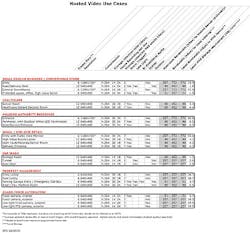2011 began with a strong, evolutionary consumer trend of bringing virtualized High Definition content directly to our IPTV, gaming console, personal computer and mobile platforms. Virtual desktops empower users by accessing personal information from any remote server, aka 'the cloud.' This same technology delivery platform, namely managed video solutions, is bringing virtualized surveillance to the security professional.
Still, some in the physical security profession may be hesitant to consider a hosted video solution because of the misconception that HDTV and megapixel resolution video consume too much bandwidth. In reality, the IT mobility of cloud-based managed video and digital multimedia not only can deliver HDTV content but can help manage high resolution video sources and storage located at the secured facility. The flexibility is here today but it does require understanding the user's needs and properly configuring the hosted system.
Stream stronger with these steps
Work with the end-user to agree on which cameras-it could be all, it could be only one-require a high-resolution recording for identification. If there is a desire to stream better than SVGA quality at reasonably high frame rates (or full frame rate offered by HDTV), you'll need to configure the hosted video solution to work efficiently within that user's connectivity constraints through a few simple steps:
1. Set recording resolution in the virtualized video hosting application to receive video content streamed on motion-based or audio-based analytics, or external event triggers, such as door contacts or access control devices connected via I/O ports to the cameras. This event-based recording can be streamed at a reduced rate of images per second, enabling the system to record standard definition video event content efficiently in the cloud.
2. If possible, improve the Internet connectivity to a symmetric connection allowing video to be more efficiently served upstream to the "cloud" application.
3. Add a network attached storage (NAS) device local to the surveillance video source and you can receive high definition streams at higher bit rates without impacting the user's Internet connectivity. This too can be configured to accept HDTV and/or megapixel video on event-based triggers, if the user desires optimum efficiency from the NAS device.
4. Now your video source is delivering event-based content to the server, while streaming high definition and redundant content to a sophisticated, scalable compact storage device anywhere in the user's protected space.
5. This creates the ability to distribute live and recorded video content efficiently from virtualized server location directly to mobile devices carried by the users and revealing, for example, peak store traffic, after-hours security entry locations, virtual guard tours and critical events in progress.
Ask the right questions for each application
While these steps sound great in theory, most integrators will ask themselves at this point: what does typical bandwidth usage look like for these scenarios? To answer this accurately, it's best to start with a typical real-world scenario. Let's look at a convenience store surveillance application.
In this application, we've got both standard and high-definition network cameras, recording both on event triggers and continuous, lower rate to both the cloud-hosted video application and a local NAS device.Here's a brief summary of some sample storage calculations (Note: These calculations were made using the Axis Design Tool, which can be found at: http://www.axis.com/products/video/design_tool/index.htm):
NAS storage required for 640x480 camera (6 fps)=2.64 GB/day
1 fps: 0.7 GB/day
6 fps: 2.6 GB/day
12 fps: 4.6 GB/day
24 fps: 7.9 GB/day
NAS storage required for 1280x720 (720p) camera (6 fps)=7.9 GB/day
1 fps: 2 GB/day
6 fps: 7.9 GB/day
12 fps: 13.9 GB/day
24 fps: 23.7 GB/day
Here are some sample 640x480 camera bandwidth requirements:
1 fps: 66 kbps
6 fps: 257 kbps
12 fps: 452 kbps
24 fps: 770 kbps
Here are some sample 1280x720 (720p) camera bandwidth requirements:
1 fps: 198 kbps
6 fps: 772 kbps
12 fps: 1356 kbps
24 fps: 2310 kbps
The above calculations are based on continuous viewing and recording. When we consider event recording, our storage and bandwidth can often be in the range of 10 to 20 percent of these figures, permitting, for example, four cameras in a typical convenience store to require approximately 220 kbps total bandwidth (to the cloud) of event recording at 640x480 resolution and 6 fps; and 31.6 GB per day of local NAS 1280x720 (720p) storage. Since NAS devices today offer 2TB of storage starting at less than $250.00, integrators can create this efficient solution for the end-user.
The drive for hosted video lives on
Cost-effective, Internet connectivity, coupled with efficient security devices are among the drivers for these hosted video deployments-which for the integrator creates enticing RMR opportunities. Ever-expanding network bandwidths and highly robust Internet security protocols are paving the way while highly-trained hosting service providers are emerging as viable alternatives to traditional in-house control.
Inexpensive, yet powerful NAS devices do their part to be used for onsite high-resolution storage as the user desires. But remember, this isn't just for storing HDTV quality video-it also provides peace-of-mind redundant storage for users who might be hesitant to let go of the idea of a proprietary storage device.
Finally, let's not forget about the power and attractiveness that mobile video will have in opting for a hosted solution. GSMA, a trade group for the mobile industry, predicts 15 billion mobile devices will be in use by 2020. Today's security professional approaches and analyzes data in many different ways and the hosting service provider is ready to deliver. As 4G networks continue their growth around the country, the hosting provider will be armed with more power. Smartphones and tablets connect securely to virtual private networks and allow authorized security personnel to monitor video from network cameras, disable card access and lock down doors in real-time. The security team can also search and retrieve archival information on-demand.
When considering hosted video solutions, remember that the current core market will be small camera count installations (typically less than 10) that are likely still using analog technology. With these solutions, users typically record video at five-to-eight frames per second at CIF or 4CIF resolution to save on internal storage. So, standard bandwidth capabilities permit the quality of network hosted video to be better than what they are used to with the world of analog.
Today's successful service provider not only recognizes the need to participate in this evolutionary virtualization of the security industry, but to succeed in it. The hosted service needs to be elastic and meet their customer's long-term security data usage, storage and monitoring needs.






